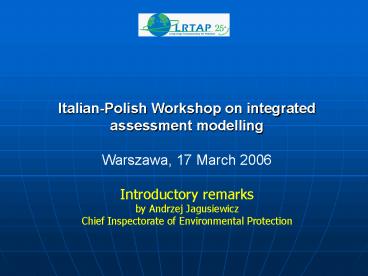Slajd 1 PowerPoint PPT Presentation
1 / 9
Title: Slajd 1
1
Italian-Polish Workshop on integrated assessment
modelling Warszawa, 17 March
2006 Introductory remarks by Andrzej
Jagusiewicz Chief Inspectorate of Environmental
Protection
2
THE CONVENTION ON LONG-RANGE TRANSBOUNDARY AIR
POLLUTION 50 Parties in Europe, North America and
Central Asia
3
Executive Body
Implementation Committee
EMEP Steering Body
Working Group onStrategies and Review
Working Groupon Effects
ICP Forests Task Force
Programme Coordinating Centre
Task Force Emission Inventoriesand Projections
Expert Groups on PM/ Ammonia Abatement
ICPIntegrated Monitoring Task Force
Task Force Measurement and Modelling / HTAP
Task Forceon Heavy Metals
Programme Centre
ICP Modelling and Mapping Task Force
Coordination Centre for Effects
Chemical Coordinating Centre
Network of Experts on Benefits and Economic
Instruments
ICP Materials Task Force
Meteorological Synthesizing Centre-West
Main Research Centre
Expert Group on Techno-economic Issues
ICP Vegetation Task Force
Meteorological Synthesizing Centre-East
Programme Centre
Task Force on POPs
ICP Waters Task Force
Task Force Integrated Assessment Modelling
Programme Centre
POLICY
Centre Integrated Assessment Modelling
Task Force Health
SCIENCE
4
CONVENTION ON LONG-RANGE TRANSBOUNDARY AIR
POLLUTION
Science..
- Science and policy have been brought close
together in a manner acceptable to scientists and
policy makers due to modelling - The monitoring programmes (modelling and
measurements) are an important strength and
becomes a compliance tool - Multi-pollutant and multi-effect approach and its
optimisation resulted in national emission
ceilings (Gothenburg vs CAFE) - Constant development
5
Negotiating effects-based emission ceilings
Abatement options and their costs
Emissions projections
Critical load maps, critical levels,
environ-mental data
Source - receptor relationship (atmospheric
transport)
Integrated assessment model
Environmental targets
Scenario analysis
Cost minimization
Negotiations
Benefit assessment
Protocol emission ceilings/NECD/TREATY
6
Scale issues Cointinental/regional integrated
assessment modelling RAINSgtCLRTAP-CAFE Effects at
the local/urban level and at the global scale are
attracting interest and drive policy and
international cooperation. Using a
multi-pollutant, multi-effect approach provides
possibilities for considering these issues as
well and if treated together there can be
pay-offs!
7
Multi-pollutant / multi-effects approach
extended version for a future strategygtchallengin
g modelling
8
CONVENTION ON LONG-RANGE TRANSBOUNDARY AIR
POLLUTION
- Shortfalls .......
- UE-25 too small to optimise cost
- Implementation throughout the ECE region, in
particular in EECCA (Eastern Europe, Caucasus and
Central Asia) countries and North America (ozone) - Lack of national RAINS
- Integrate hot-spotsgtcities
9
CONVENTION ON LONG-RANGE TRANSBOUNDARY AIR
POLLUTION
Present and future needs ..
- Consider between-region/hemispheric movement of
air pollution - cooperate with other regions,
including North and South of Europe - Investigate synergies between emissions and
effects of traditional air pollutants and the
emissions of climate forcing gases - Develop RAINSgtGAINS and integrate all scales

